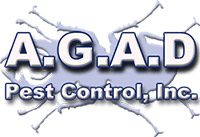A.G.A.D. Pest Control’s most important employee, a BED BUG DOG, named NYX. Nyx is a smoothed haired fox terrior and she sniffs out and detects BED BUGS. Please vist our subsidiary company at www.illinoisbedbugdog.com for more information or call us to find out how you can have NYX come and search out Bed Bugs for you.
Bed Bug/Heat Application
A.G.A.D. Pest Control, Inc. founded in 1982 now has the most powerful and the most versatile Bed Bug heat system available. This system is a 250,000 BTU Thermal Energy System power plant which generates an intense, clean, dry high temperature heat with a unique heat exchange fluid. The fluid is transferred with a high volume pump through specially-designed insulated hoses to a Thermal Exchanger box, we then connect 6 heat boxes that produce 40,000 BTU’s each of heat. This system is completely portable and only needs 8 amps (1 normal household plug) for power. We are able to treat up to the 3rd floor from the trailer mounted unit, after the 3rd floor as long as there is an elevator we can transport this system to any floor which makes it the most powerful and most versatile Bed Bug heat system available.
The Thermal Energy System’s 250,000 BTU’s will allow us to heat up the entire structure to the desired tempature of 135 degrees quicker than any other system. This might not seem important but it is because bed bugs will start moving after the temperature reaches 100 degrees. If the treatment is in a multi family dwelling and it takes too much time to reach the desired 135 degrees the bed bugs can and will move to another unit.
Bed Bug Organic Pesticide Application
The only pesticide A.G.A.D. Pest Control, Inc. uses to eliminate bed bugs is an organic dust.
WHY WE ARE BETTER
Until now there have been two different types of bed bug heat applications. First is a direct fired propane heater, this application will introduce large quantities of water as a combustion by-product, it will produce more than 5 gallons of water to the indoor air every hour and typical application time is 6 hours. The direct fired propane heat system not only produces 30 gallons of water to the dwelling it is also visually intrusive with the running of large ducts that carry the hot air from the truck. Second type is portable electric heaters, this system is safer because it is a dry heat but it has its limitations due to the thick electric cords that must be run from a large noisy generator to the treated area. Typically treating up to the 3rd story is no problem after that it is very difficult if not impossible.
How to Inspect for Bed Bugs
When you suspect there is a bed bug infestation check all possible hiding spots and be ware that bed bugs can fit into tiny cracks and crevices. Any tight spot that a credit card can fit into, a bed bug can fit into as well. Make sure you also check your pets because bed bugs will prey on animals when sufficient human hosts are not available.
In the early stages of an infestation, bed bugs will be found around the seams and tufts of the mattress so this is where you should begin your search. Later on, they’ll spread to cracks in the bed frame and then to gaps behind baseboards, pictures, window and door casings, wallpaper, carpet edges, peeling paint, and other similar shelters. Pay close attention to the 10-20 foot radius around where you sleep or rest. That’s the most common distance that bed bugs travel from their host.
Check for spots of blood left on bed sheets that indicate bed bug biting. Check for brownish black specks that are the bed bug feces and bed bug shells that are the bed bug exoskeletons.
Some areas that you should focus on during your search are:
- Seams, creases, tufts, and folds of the mattress and box spring
- Cracks in the bed frame and headboard, and all screw holes
- Between the cushions of upholstered furniture
- Edges of carpets, especially behind the bed
- Between the folds of drapery or curtains
- In the drawers of night stands, dressers, etc
- Behind the baseboards
- Around door and window casings
- Behind electrical switch and outlet covers
- Under loose wallpaper, peeling paint, paintings, posters, etc
- In cracks in the plaster
- In telephones, radios, clocks, and similar places
Keep a written record of every room and location where you find signs of bed bugs. Even though the infestation likely goes far beyond what you’re able to see, it’s good information to have handy when you contact a pest control professional to deal with the infestation.

